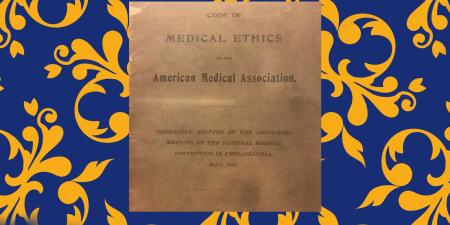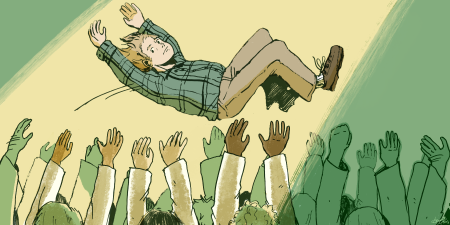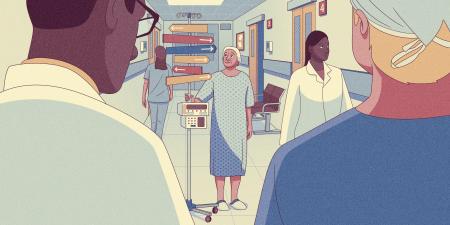Abstract
Technology-dependent patients require interventions (eg, tracheostomies, gastrostomy tubes, or total parenteral nutrition) to survive. Such patients are commonly “turfed” between general services or from subspecialty to general services within the hospital. This case commentary proposes several explanations for why technology-dependent patients are particularly susceptible to turfing, including clinicians’ lack of familiarity with managing patients’ technology, bias and ableism, and quality-of-life quandaries. It also addresses ways to combat turfing of technology-dependent patients and proposes educational strategies for managing common problems in the care of technology-dependent patients.
Case
JJ, a 7-year-old with a history of cerebral palsy, epilepsy, global developmental delay, and gastrostomy tube dependence, is seen in plastic surgery clinic for a chronic decubitus ulcer. Although JJ is clinically stable, the surgeon, Dr S, determines that, since JJ’s ulcer is worsening, JJ should be admitted for wound care and surgical debridement. Plastic surgery team members are not comfortable managing JJ’s general medical and equipment needs and request that JJ be admitted to a general pediatric service, led by Dr P. Dr P considers whether the pediatric team should manage JJ’s perioperative care or whether the plastic surgery team should take primary responsibility for the patient. Dr P considers how to respond to Dr S.
Commentary
“Turfing” occurs when patients are transferred for nonmedical reasons to an inpatient service that will not address their primary reason for admission. To date, no studies that we know of have specifically identified risk factors for turfing; in our experience, patients with medical complexity and technology dependence often appear to be at greater risk. When care of a particular patient becomes challenging in one of a variety of ways, the patient might be turfed, an experience that can harm the therapeutic alliance between patients, families, and medical teams.1 Turfing might thus be framed as a morally and ethically problematic abdication of responsibility by the turfing team; however, one might also argue that patients with medical complexity should be transferred to the service most experienced in caring for this patient population. In a case like JJ’s, what criteria should we use to determine the appropriateness of a transfer? In this article, we define technology dependence, propose why technology-dependent patients might be particularly susceptible to turfing, and provide recommendations on how to meet clinically complex patients’ needs in ways that are caring and robustly responsive to their unique vulnerabilities.
Characterizing Technology Dependence
The term technology dependence was first used in the 1980s to describe a growing population of children with previously life-limiting conditions whose survival was due to new technological innovations. A 1987 report identified technology dependence in children according to these criteria: ventilator dependence, total parenteral nutrition dependence, and any other device-based support of vital functions (eg, tracheostomy, gastrostomy tube, home oxygen, colostomy, dialysis).2 Since then, these interventions have become widespread in the care of both children and adults. In 2005, 20% of pediatric inpatients at one regional tertiary care hospital were dependent on at least one medical device.3 Based on data from the Eurovent survey, one study estimated that 20 377 adults and children in the United States in 2010 required long-term ventilator use.4 In 2008, it was reported that 46 510 tracheostomies were placed in adults and children in the United States.5 Gastrostomy tubes are even more common, with an estimated 437 882 Medicare patients in the United States relying on them for enteral nutrition in 2013.6 While it is difficult to characterize the population of technology-dependent adult inpatients since the term technology dependence is primarily used in pediatric populations, it has been shown that, for example, adult patients with recent tracheostomy placement are frequently hospitalized and have poor clinical outcomes.7
Despite the growing prevalence of technology-dependent patients, many clinicians are uncomfortable caring for this population. Pediatricians often feel they have limited training in the management of gastrostomy tubes, tracheostomies, and other technologies; consequently, managing patients with these devices can provoke anxiety.8,9 Emergency medicine residents likewise express a lack of confidence in caring for technology-dependent patients.10 Tracheostomy management skills do not significantly improve during internal medicine residency, indicating that these skills are either not included in internal medicine curricula or are not mastered during training.11 These findings raise concerns that clinicians in the primary services to which technology-dependent patients might be transferred are themselves not comfortable with the management of the technologies required by these complex patients.
Proposed Explanations for Turfing Technology-Dependent Patients
In our experience, it is not uncommon for technology-dependent patients to be admitted or transferred to the pediatric, internal medicine, or general surgery services regardless of their reason for admission. We have observed that this practice is sometimes based on the rationale, whether or not justified, that subspecialty services lack the expertise to manage these patients’ complex medical and technological needs. Technology-dependent patients also acquire an “undesirable” status likely due, at least in part, to clinicians’ sense of inadequate proficiency.8 Consequently, we have noted that the admission of technology-dependent patients to primary medical, pediatric, or surgical services can be a source of resentment for members of the primary service, particularly if team members feel that they are not providing any specialized care.12 To subspecialty teams, these complex patients fall within the purview of general medical, pediatric, or surgical services. To general services, a sense remains that someone else must have greater expertise—whether or not this is actually the case. Here, we discuss 4 reasons why clinicians might turf technology-dependent patients.
As mentioned, some clinicians might hesitate to take primary responsibility in caring for technology-dependent patients because of a sense of clinical unfamiliarity. A 2021 survey found that only 41% of physicians feel “very confident” in their ability to provide equal care to patients with disabilities, a category to which technology-dependent patients often belong, and only 57% “strongly” welcomed patients with disabilities in their practices.13 Only a few residency programs have published formal curricula that cover patients who are disabled or technology-dependent,14 suggesting a larger institutional deprioritization of this population. On the other hand, some clinicians’ unwillingness to care for technology-dependent patients may be simply a recognition of their limitations, particularly if they practice in a specialty or geographic area where these patients are uncommon. For example, technology-dependent patients and their caregivers tend to seek treatment in urban areas with specialized hospitals,15 which may improve some patient outcomes. However, this tendency also means that clinicians in less specialized centers rarely see these patients, creating a feedback loop that further concentrates expertise in urban areas.15,16
Despite growing numbers of technology-dependent patients, many clinicians are uncomfortable caring for them.
Unconscious clinician bias and ableism may also contribute to turfing of technology-dependent patients. It is important to note that many patients with technology dependence also have physical or cognitive disabilities, which may lead to their being stigmatized by clinicians. Physicians as a group are overwhelmingly non-disabled, with an estimated 3.1% of physicians and 4.6% of medical students in 2019 identifying as disabled,17,18 compared to 26.8% so identifying in the general population.19,20 Physicians’ lack of personal familiarity with disability may lead to their underestimating the quality of life of people with disabilities: 82% of physicians believe that people with disabilities have a lower quality of life than those without disabilities despite this belief being unsubstantiated13 (ie, the so-called “disability paradox”21). Physician ableism is likely exacerbated by the medical training process, which emphasizes intellectual ability (to succeed in college and medical school) and physical resilience (to cope with long shifts and frequent sleep deprivation). After progressing through a pipeline that prioritizes these qualities, physicians may consciously or unconsciously adopt a mental model that devalues individuals with physical or cognitive disabilities.
Clinicians’ professional priorities can also play a role in stigmatizing technology-dependent patients. Clinicians may aspire to discharge patients with their medical problems “cured” or definitively treated—a goal that is rarely feasible in technology-dependent patients with multiple, chronic conditions. In situations in which a cure is clearly impossible, clinicians have been demonstrated to manage their own feelings of inadequacy or helplessness by mentally, physically, or emotionally distancing themselves from the patient.22 Subspecialty teams might engage in physical distancing by turfing the patient to another service; primary teams might engage in metaphorical distancing, manifested as resentment toward the patient or the turfing team or disengagement from the patient’s care. As a result, patients might perceive a signal of “unwantedness” that can harm the therapeutic alliance.1
Finally, clinicians caring for technology-dependent patients may have concerns about patients’ quality of life and medical futility. Long-term, life-sustaining interventions, such as home ventilation, have become more widely available, so patients previously deemed ineligible for these technologies due to poor prognosis may now be offered these treatments. However, some clinicians have expressed concern that offering certain pediatric patients long-term home ventilation is “pushing the ethics limits.”23 Such concerns may be rooted in the perception that the harms of ongoing medical technology use—frequent hospitalizations, additional medical procedures, increased infection risk—outweigh the benefits. Clinicians obligated to provide such interventions despite these concerns might experience moral distress, particularly if they feel that the intervention causes suffering or that the patient is unable to give consent.24 In the face of morally distressing circumstances that clinicians cannot change, clinicians might, as described above, attempt to avoid the patient or disengage emotionally from the patient’s care.22 Turfing can thus function as a mechanism through which some clinicians attempt to avoid moral distress or uncertainty—regardless of whether clinicians are aware of their intentions.
Recommendations
At the institutional level, additional training in technology-dependent patients’ unique needs is a necessary first step in mitigating turfing and improving care for this patient population. If all medical trainees—not just those in primary medical specialties like internal medicine, pediatrics, and general surgery—receive practical education in managing common technology-related problems, subspecialty services might feel more ready to take on primary responsibility for technology-dependent patients. It is important to note that some technologies are more common and easier to maintain, while others are complex and might require additional technical or clinical expertise.
Education can also be beneficial in addressing stigma, which could stem from the perception of technology-dependent patients as “high maintenance,” given that they often have a high level of case management and psychosocial needs.8 Following the lead of diversity, equity, and inclusion initiatives addressing other forms of discrimination in medicine,20 efforts to admit larger proportions of disabled medical trainees may (among other benefits) weaken ableist norms and beliefs in the clinician workforce. Additionally, programs that facilitate relationships between technology-dependent individuals, caregivers, and clinicians outside the hospital could help counterbalance the view of technology dependence as synonymous with illness and misery. These initiatives should be implemented throughout the continuum of clinical training and practice. Social workers specializing in medically complex patients could also help mitigate the demands that patients’ psychosocial needs can place on clinicians. However, clinicians attempting to offload technology-dependent patients’ case management needs via turfing must maintain awareness that managing these needs is not solely the province of “generalist” services.
Conclusion
It is incumbent on all clinicians who allocate responsibility for the care of technology-dependent patients to recognize the medical profession’s role in creating this patient group and thus the obligation to care for this group. There is no easy answer for services faced with the complex decision of whether to transfer a technology-dependent patient to a different service. Even with improved educational initiatives and reduced stigma, patient complexity and clinicians’ level of comfort in caring for technology-dependent patients will vary. However, a label of “medically complex” or “technology-dependent” should not mandate that a patient be placed on a general service if another service is better equipped to address that patient’s primary reason for admission. Subspecialty services needing additional support in managing technology-dependent patients’ chronic complex medical needs can work together with general medicine consult services—or, in academic pediatric centers, the new field of complex care medicine25—while still retaining these patients on their primary service. Most importantly, the choice of a patient’s primary service should reflect the most pertinent needs of that specific patient, at that specific time.
References
- Caldicott CV, Dunn KA, Frankel RM. Can patients tell when they are unwanted? “Turfing” in residency training. Patient Educ Couns. 2005;56(1):104-111.
-
Office of Technology Assessment, US Congress. Technology-Dependent Children: Hospital v Home Care—a Technical Memorandum. US Government Printing Office; 1987. OTA-TM-H-38. Accessed August 31, 2023. https://ota.fas.org/reports/8728.pdf
-
Feudtner C, Villareale NL, Morray B, Sharp V, Hays RM, Neff JM. Technology-dependency among patients discharged from a children’s hospital: a retrospective cohort study. BMC Pediatr. 2005;5(1):8.
- King AC. Long-term home mechanical ventilation in the United States. Respir Care. 2012;57(6):921-930.
-
Friedman B, Henke RM, Wier LM; Healthcare Cost and Utilization Project. Most expensive hospitalizations, 2008. Agency for Healthcare Research and Quality. October 2010. Statistical brief 97. Accessed July 28, 2023. https://hcup-us.ahrq.gov/reports/statbriefs/sb97.jsp
- Mundi MS, Pattinson A, McMahon MT, Davidson J, Hurt RT. Prevalence of home parenteral and enteral nutrition in the United States. Nutr Clin Pract. 2017;32(6):799-805.
- Mehta AB, Walkey AJ, Curran-Everett D, Douglas IS. One-year outcomes following tracheostomy for acute respiratory failure. Crit Care Med. 2019;47(11):1572-1581.
- Bogetz JF, Bogetz AL, Rassbach CE, Gabhart JM, Blankenburg RL. Caring for children with medical complexity: challenges and educational opportunities identified by pediatric residents. Acad Pediatr. 2015;15(6):621-625.
-
Frush BW. Preparing residents for children with complex medical needs. Pediatrics. 2020;145(5):e20191731.
-
Kamzan A, Jun-Ihn E, Kulkarni D. On the front lines of pediatric complex care: are we preparing emergency medicine residents? Hosp Pediatr. 2020;10(8):712-714.
- Tokarz E, Szymanowski AR, Loree JT, Muscarella J. Gaps in training: misunderstandings of airway management in medical students and internal medicine residents. Otolaryngol Head Neck Surg. 2021;164(5):938-943.
- Stern DT, Caldicott CV. Turfing: patients in the balance. J Gen Intern Med. 1999;14(4):243-248.
- Iezzoni LI, Rao SR, Ressalam J, et al. Physicians’ perceptions of people with disability and their health care. Health Aff (Millwood). 2021;40(2):297-306.
-
Huth K, Long-Gagne S, Mader J, Sbrocchi AM. Understanding the needs of children with medical complexity. MedEdPORTAL. 2018;14:10709.
-
Moynihan K, França UL, Casavant DW, Graham RJ, McManus ML. Hospital access patterns of children with technology dependence. Pediatrics. 2023;151(4):e2022059014.
- Russell CJ, Simon TD. Care of children with medical complexity in the hospital setting. Pediatr Ann. 2014;43(7):e157-e162.
-
Nouri Z, Dill MJ, Conrad SS, Moreland CJ, Meeks LM. Estimated prevalence of US physicians with disabilities. JAMA Netw Open. 2021;4(3):e211254.
- Meeks LM, Case B, Herzer K, Plegue M, Swenor BK. Change in prevalence of disabilities and accommodation practices among US medical schools, 2016 vs 2019. JAMA. 2019;322(20):2022-2024.
-
Varadaraj V, Deal JA, Campanile J, Reed NS, Swenor BK. National prevalence of disability and disability types among adults in the US, 2019. JAMA Netw Open. 2021;4(10):e2130358.
-
Kaundinya T, Schroth S. Dismantle ableism, accept disability: making the case for anti-ableism in medical education. J Med Educ Curric Dev. 2022;9:23821205221076660.
- Albrecht GL, Devlieger PJ. The disability paradox: high quality of life against all odds. Soc Sci Med. 1999;48(8):977-988.
- Back AL, Rushton CH, Kaszniak AW, Halifax JS. “Why are we doing this?”: clinician helplessness in the face of suffering. J Palliat Med. 2015;18(1):26-30.
- Alexander D, Quirke MB, Doyle C, Hill K, Masterson K, Brenner M. The meaning given to bioethics as a source of support by physicians who care for children who require long-term ventilation. Qual Health Res. 2022;32(6):916-928.
- Dzeng E, Colaianni A, Roland M, et al. Moral distress amongst American physician trainees regarding futile treatments at the end of life: a qualitative study. J Gen Intern Med. 2016;31(1):93-99.
- Agrawal R. Complex care in pediatrics: great progress, greater challenges. J Pediatr Rehabil Med. 2015;8(2):71-74.



